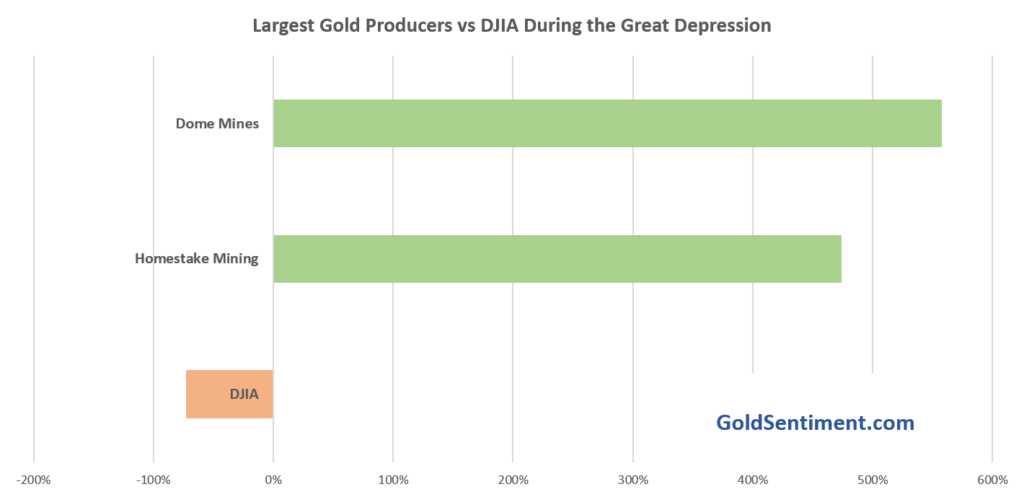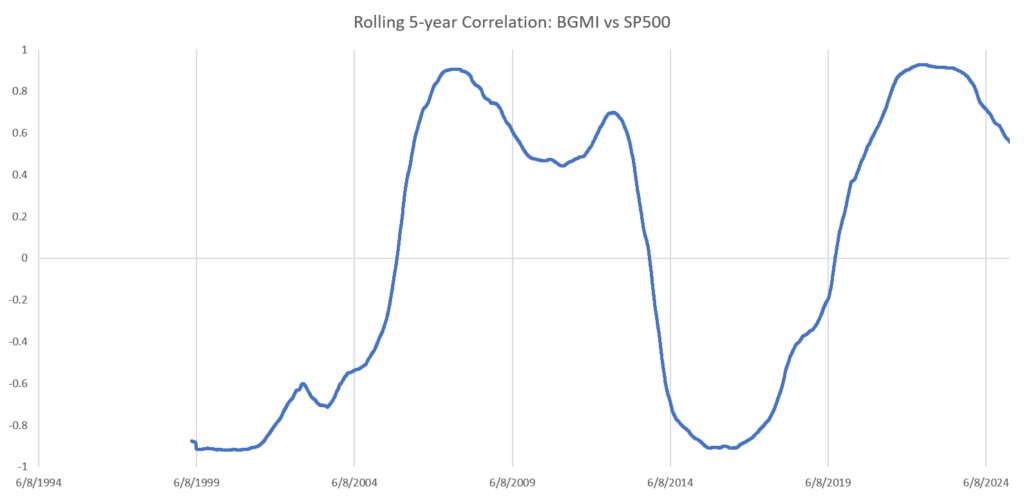Gold mining stocks can be a compelling way to invest in gold, silver, and other precious metals. If you haven’t previously considered this investment, you may find these companies to be an interesting way to gain exposure to the sector.
While surely not the same as investing in the physical metal itself, owning these mining companies can align your portfolio with the long-term performance of the precious metals they produce. Depending on the company, these metals can include gold, silver, platinum, and palladium.
With mining companies, the greater the company’s ore production or the higher gold prices rise, the better its performance will likely be. Importantly, gold and silver mining stocks do offer some unique challenges compared to investing directly in bullion, such as 1 oz gold coins. However, they also hold unique benefits and, therefore, it’s up to each investor to determine which option makes sense for their investment goals.
Key Takeaways
- Gold mining companies offer investors a convenient way to invest in a gold-related asset with the simplicity of buying a stock or ETF.
- Historically, gold mining stocks exhibit a counter-cyclical behavior and have been a strong diversifying force within a traditional portfolio.
- Unlike physical gold or silver, gold mining companies require CAPEX and have day-to-day operating expenses which can act as a performance drag.
- Gold mining stocks were one of the only positive-performing investments during the Great Depression and the 1973-74 bear market.
Historical Performance of Gold Mining Stocks
Gold mining stocks possess a wonderfully counter-cyclical profile, one that lends itself to nicely diversifying a portfolio of other stocks and bonds. In fact, gold mining stocks historically shine the most during periods of stock market and economic volatility. For example, the Great Depression and the brutal 1970’s bear market.
The below table shows the performance of the two largest gold miners versus the Dow Jones Industrial Average during the Great Depression:
The historical performance of gold mining stocks, in aggregate, can be equated to a combination of the stock market and gold. They are, of course, heavily tied to gold, but are also subject to the whims of the financial community with factors such as: institutional buying and selling, interest rates, currency fluctuations, labor issues, inflation, and others.
These companies can tremendously outperform gold at times and they can also underperform for long stretches of time as well. Although highly aligned with precious metals prices, they do incur sizable costs to operate. This capex and day-to-day operating costs sometimes act like an anchor to performance.
The below chart shows the price history of the Barron’s Gold Mining Index (BGMI) since its inception back to 1939.
The performance of BGMI over the past century shows how these mining companies can perform as investments. Important to consider though is how that index performs relative to gold, this ratio is shown in the below chart.
Note that gold outperforms the BGMI index over the very long-term, which can be seen via the general downward trend over the decades. However, also note the violent rallies that show strong performance for mining shares for months or years at a time.
Adding to the difficulty, risk, and reward is selecting a fund or individual mining companies. As with anything, higher levels of risk (small, “junior miners”) can result in greater returns. Conversely, large “blue chip” miners can be safer and less volatile but may result in lower returns.
Most investors interested in gold will be deciding whether to invest in gold itself or, instead, in mining companies. These investors should find it useful to review this chart showing the relative performance of mining companies to gold. The above chart shows this historical relationship and illustrates periods of dramatic swings; both assets shine at different times.
A Great Diversifier with a Low Correlation to Stocks
The basic building blocks of a properly diversified portfolio are individual assets with a near-zero correlation to each other. Specifically, uncorrelated assets with a positive expectancy. Fortunately for investors, gold mining shares tend to have a very low correlation to the broad stock market.
The below chart shows the rolling 5-year correlation between the Barron’s Gold Mining Index (BGMI) and the S&P 500. Note how it oscillates between the extremes of +1 and -1 (the limits for correlation) and, over time, averages out to essentially zero.
How do Mining Companies Provide Gold Exposure?
Gold mining companies engage in the act of mining gold, silver and, sometimes, other metals. After the exploration stage and mine development, they use heavy equipment to mine ore from the earth and extract the gold through various methods. This gold is typically sent to a refinery where it is further refined to the required specifications and sold on the open market.
Their profits, assuming stable mining and exploration costs, should be a direct function of the price of gold and the volume they extract from the mine. A company with steady operations and meaningful reserves should be more exposed to the price of gold or silver, and less to the volatility that accompanies some smaller mining operations that focus on growth or have yet to produce.
On the other hand, mining companies that engage in exploration activities may be able to benefit from additional gold discoveries in addition to any rise in the price of gold or silver. By now it should be clear that exploration and mining remain a double-edged sword as these activities are capital and time intensive. To this point, failed exploration and inefficient operations mean additional costs, couple this with potential lower gold prices and mining companies can, at times, be poor investments.
Geographic Considerations
Investor Hugh Hendry made an interesting point years ago when he observed that a gold mining company’s risk profile may actually deteriorate as gold prices rise due to the increasing temptation of seizure from local governments. In other words, he proposed that a mining company’s sovereign risk rises along with the price of gold.
Would a non-western country with non-western property rights face temptation to seize a producing mine? Would they tolerate a western company extracting an increasingly valuable commodity from their homeland? I say “maybe not” and the risk of such is worth considering.
For example, Franco Nevada Corp, a gold royalty company faced a similar issue back in 2023. One of their royalty streams, the Cobre Panama mine had been in the crosshairs of environmental protestors for some time. Many Panamanians argued that First Quantum Minerals obtained their mining permit illegally. They also argue that its location, in an important rain forest, was causing irreversible environmental damage. In 2023, the Panamanian supreme court agreed, and shut down operations.
As a result, Franco Nevada’s stock price proceeded to drop over 25% due to forces completely out of their control.
Available Gold Mining ETFs
For investors interested in purchasing a gold mining ETF, many options exist. At least four separate companies offer sizable funds for individual investors to purchase through their online brokerage platform. The largest, by far, are VanEck’s products. However, Sprott, a reputable Canadian investment firm, is highly regarded and their ETFs can be considered as well. The below table lists the most liquid (i.e. largest) ETFs with their name, ticker symbol, and approximate assets under management as of March 2025.
Lastly, an interesting additional option exists in the form of a publicly-traded company here in the USA. ASA Precious Metals (ASA) is a holding company that invests its assets in a basket of gold mining companies. It’s not an ETF, but serves a similar function. It may be worth researching as you evaluate the available options.
Available ETFs:
VanEck Gold Miners ETF (GDX), $14,228m
VanEck Junior Gold Miners ETF (GDXJ), $5,075m
Sprott Gold Miners ETF (SGDM), $296m
Sprott Junior Gold Miners ETF (SGDJ), $134m
US Global GO GOLD Miners ETF (GOAU), $98m
Global X Gold Explorers ETF (GOEX), $44m
Summary
Ultimately, done with care, gold mining stocks can serve you and your portfolio for the long-term. With that said, a convenient summary of the pros and cons of investing in these companies is included below:
Pros
Cons
Easy to purchase
Can underperform gold due to CAPEX requirements and/or poor corporate management
Can show tremendous growth through capital appreciation and dividends
Not a “pure-play” on gold
Counter-cyclical, low correlation to the broad stock market
Can be vulnerable to stock market volatility
Can be a useful inflation hedge
foreign assets subject to sovereign risk
No worry about security and storage of physical bullion
Typically higher risk and price volatility
Precious metals mining companies have a devoted following of investors for many reasons. Their historical performance and unique characteristics make them a tempting option for investors interested in gold and silver.
However, it should be clear by now that investing in these companies can be challenging, particularly if you are trying to outperform the price of gold. Strong research should be a prerequisite to anyone buying individual companies and everyone else should likely consider a fund which invests in several, if not dozens, of gold mining stocks.

Author
Andrew McCormick, RIA is the Senior Portfolio Manager at Cottonwood Capital Management. Previously, he worked for BlackRock and managed the MKC Global Fund, LP. Andrew’s work has been featured in ZeroHedge, TheStreet, and the Wall Street Journal.



